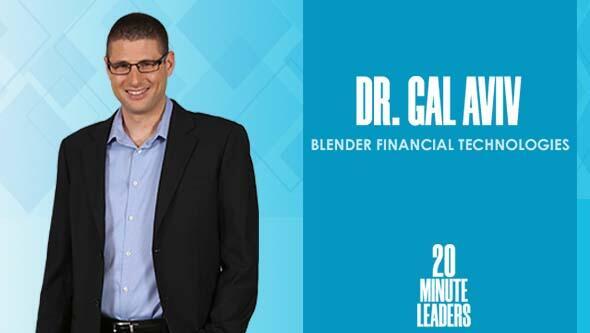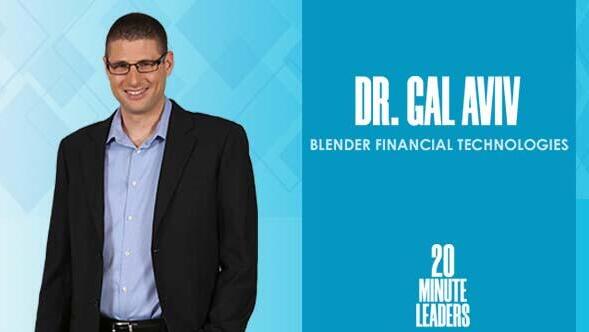
20-Minute Leaders
“The world of finance is completely changing now, and it's being rebuilt from scratch.”
A thing about FinTech lending is that after drawing in a potential client, companies must decide if they want to sell them the product or not, says Dr. Gal Aviv, CEO at BLender Financial Technologies.
A strange thing about FinTech lending is that after drawing in a potential client, companies have to decide if they want to sell them the product or not, says Dr. Gal Aviv, CEO at BLender Financial Technologies. He explains that BLender’s technology allows them to quickly analyze a borrower’s risk of default to make an instant loan decision. That speed and ease of use is even more important to customers than price, he says. Aviv shares that BLender is part of a huge shift in the financial world, from all-in-one institutions who aren’t great at anything to very focused and specific FinTech companies that can provide the exact right product. He explains that this focus on the customer’s needs and what drives them is very similar to the passion he had throughout his physics studies as he worked to understand what drives systems.
Click Here For More 20MinuteLeaders
You have a PhD in nanophysics. And today, you're running BLender, doing some phenomenal things in the lending world. How does one make the transition from physics to Fintech?
From becoming a scientist to moving to the business world, and from the business world to to FinTech, it's quite a fast transition. It mainly relates to our passions as people. For me, what drives us is a big thing.
In the world of physics, we try all the time to explore and to understand. And you understand that you understand almost nothing. But you try to find out the drivers that drive people and systems.
In the world of business, I think it's quite the same. All the time, it's to think of your clients, what drives them, what brings them to use your product, and how can your product be better for them.
Walk me through yourself, as an entrepreneur, as an executive, as an academic. How did you grow into these fields?
I have done sports for many, many years. I raced in sailing for ages. I'm a seasoned runner as well. I started physics, I think, through a passion. When I started a PhD, I was accepted to a phenomenal lab in the UK that was doing atom chips. We reduced our temperature to absolute zero where there is no movement. It's like living in a completely different world.
But in parallel to all of that, I was all the time around the world of investments and venture capital. The first startup I built was in 2004, I think. It was in medical devices. Then I moved to investments a few years later. I built a company that was investing in venture capital that's in the bridging state. We had involvement in 13 different companies and seven of them succeeded.
But when I finished a PhD in England and we came back in 2012 to Israel, there was this passion to build something. From this passion, BLender came. We are a wonderful group of founders. It's myself, my brother, and another friend who did physics studies in undergrad and master's with me. Together, we started BLender, which is very different and unique from what we thought in the beginning.
Even before we talk about BLender, how do you see the world of loans?
It's not just the world of lending, I think the whole world of finance and FinTech is completely changing now, and it's being rebuilt from scratch in all the aspects, in all the channels, in all the directions.
I think that what’s happening now is a process of segregation and that each of these companies become very good at specific channels. From old type banks that are trying to do all in one and actually nothing is really good to becoming very specific companies that are doing something very well. We see it in all the channels: trading, current accounts, buy-now-pay-later, and deposits.
Suddenly, we see financial institutions that are very specific. They bring a true value for the client at what they do. I think this is one of the important aspects here: being very specific, very well-focused, and bringing the exact product.
When we get to the world of lending, there was a massive change. If we start to look at LendingClub, Prosper, etc, where it was very much “get an unsecured loan and do something with it,” that is over. Now, we are in the stage of "let's control our cashflow." Let's bring products that help people to uplift themself. That means that a loan needs to be specific for a cause. You take the loan as a payment method. In order for a loan to become a payment method, you need technologies that will drive this transaction at lightspeed.
Why do existing solutions not allow for that?
There are two factors here. One is the understanding of the client and providing the client the exact products that he needs at the exact time; the second one is to have the technology and infrastructure that would allow you to create instant transactions. To do a money remittance, it's really easy.
When you provide a loan, you actually don't even send the money to the person, you send the money to a shop that he is standing at or that he is browsing at, and you presume that you will get the money back in 24 payments. You need to have a lot of technology around it to understand that there is a genuine person on the other side, and what is the risk level of the person and what is his probability of default. It's complicated.
How do you see this consumer behavior shifting? You're saying, "We, as independent people, can provide loans and not just banks." How do you think through this consumer shift?
First of all, BLender is becoming a bank here, a cross-European bank. This is the next stage of our evolution. The cost of capital of banks is the lowest in the market. You get deposits and therefore you can provide the best products for our client. Price is one of the questions from our clients. We were quite surprised that price is not the main question. The main question is the simplicity of the transaction.
You need to have exactly the product that creates the trust, and in parallel, you need to have the infrastructure to allow the transaction. Why don't banks do that so much? I don't think that they can be there so easily. It's completely different infrastructure, completely different DNA.
How does technology help facilitate the de-risking of such a situation?
Our technology has run over half a million people now, so we could really build statistical models, but in the early days or when we entered a new country, there is always this question of what you check. First of all is the anti-fraud part, who the person really is. The other side is to understand what the risk level of the client is.
We built a system that we call the "Iron Dome of anti-fraud." It combines hundreds of small checks and we look at the correlations between the small checks. They're all automated; it takes less than a second. But we accumulate all of that and that gives us a wide good picture of the person.
The other part relates to understanding the risk level of the client and what is his probability of default. There we use mainly a data basis. There are credit scoring databases; we check them. We never trust the scores, so we will always take the raw data and analyze it ourselves. And today, there is open banking. You can get access to all the transactions that the person is doing in his current account and you can analyze them. That allows the models really to be much more accurate.
This type of FinTech is very strange. It's not that you just need to gain the client, but after you gain the client, you need to ask yourself if you want to give them the product or not. That's one of the problems of FinTech in general.
How does BLender move the needle in terms of society? Or how does this impact people's lives?
We focused mainly on two channels: on car lending and buy-now-pay-later. And on the other side, with depositors. We don't believe that depositors should get a negative return. It's not reasonable. If the bank is very focused on a profitable channel, we can give to our depositors the good returns that they are looking for, and for our borrowers, good pricing and a very fast and well managed borrowing process.
Michael Matias, Forbes 30 Under 30, is the author of Age is Only an Int: Lessons I Learned as a Young Entrepreneur. He studies Artificial Intelligence at Stanford University, is a Venture Partner at J-Ventures and was an engineer at Hippo Insurance. Matias previously served as an officer in the 8200 unit. 20MinuteLeaders is a tech entrepreneurship interview series featuring one-on-one interviews with fascinating founders, innovators and thought leaders sharing their journeys and experiences.
Contributing editors: Michael Matias, Megan Ryan

